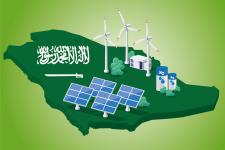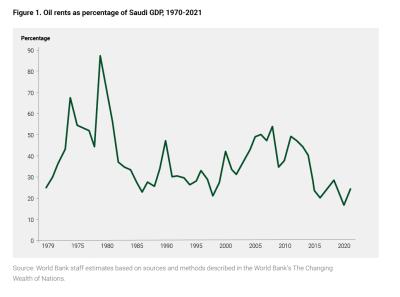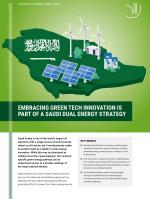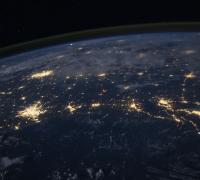Embracing green tech innovation is part of a Saudi dual energy strategy

- Although Saudi Arabia is investing in technological solutions to minimise carbon emissions, including renewable energy, protecting the oil industry is still its key priority.
- The main driver of a green transition in Saudi Arabia is to maintain and future-proof the Saudi economy, in the process reshaping the national identity to reward innovation and entrepreneurship.
- Saudi Arabia positions itself as a global leader through a combined focus on technological innovation and advocacy for individualised energy transition pathways.
Saudi Arabia is one of the world’s largest oil exporters with a single-source economy heavily reliant on oil income, yet it simultaniously seeks to position itself as a leader in clean energy innovation. While this may be dismissed as nothing more than ‘greenwashing’, the country’s specific green energy pathway can be understood as part of a broader redesign of the Saudi national identity.
Hydrocarbons are crucial to Saudi Arabia’s economy. Even so, the nation has set ambitious goals such as achieving net-zero carbon emissions by 2060 and generating 50% of its power from clean energy sources by 2030, as announced by Crown Prince Mohammed Bin Salman as part of the Saudi Green Initiative. Currently, meeting 50% of the country’s power needs equates to roughly 60 GW, but with projected population growth, urbanisation, and industrial development by 2030, this figure is expected to increase significantly.
The Saudi state acknowledges the consequences of climate change such as heatwaves, desertification, biodiversity loss, and water scarcity, and is investing heavily in renewable energy. However, the driving force behind these investments is not climate change mitigation, but an attempt to maintain and enhance the Saudi economy through a dual strategy: safeguarding oil production and positioning the nation as a global leader in clean energy innovation.
These dual objectives converge into a nationalist narrative depicting Saudi Arabia as ‘balanced’ in contrast to Western-driven appeals to immediately cease fossil fuel production and consumption. This brief elucidates the key rationales informing the Saudi approach to emissions reduction, shedding light on how it is used to garner domestic legitimacy while projecting Saudi Arabia as a technologically innovative leading nation.
The cleanest barrel of oil
The Saudi approach builds on the continued growth in global oil demand and aims to position itself as the most competitive oil producer in three ways. First, it is promoting the concept of the ‘cleanest barrel of oil’. Emissions per barrel of crude oil differ and oil from Saudi Arabia is ranked among the least damaging because of its easy-to-reach reserves. This has led Saudi Aramco president and CEO Amin Nasser to describe Saudi crude oil as having significant greenhouse gas mitigation potential.
Second, the Saudi approach emphasises that wind, solar and other renewable energy sources also have a carbon footprint and other detrimental effects on the environment. This leads to frequent references to tools such as Life Cycle Analysis (LCA) that evaluates environmental impacts of a product or process throughout its life cycle, i.e. from raw material extraction to the end-of-life, to question whether oil and gas are as bad as their reputation.
Third, there is a strong belief in the future development and scalability of technological solutions to minimise carbon emissions. This includes carbon capture and storage (CCS) technologies, that promise to reduce emissions by capturing and storing carbon dioxide emissions underground. However, these strategies are either not available on a big scale or have been criticized for relativizing the green house gas emissions of hydrocarbons as a deliberate strategy to delay and weaken support for the phasing out of fossil fuels to protect the Saudi oil industry.

Greening the energy mix
The Saudi strategy combines a focus on protecting the domestic oil industry with large investments in green energy technologies. This include the development and scalability of clean hydrogen technologies and, primarily, the development of solar farms due to abundant sunshine. However, by the end of 2023, only just over 1% renewable energy has been installed, with 6% in the pipeline and 11% announced. While the 50% target is ambitious, there is a strong popular belief in the Saudi government’s capacity to achieve what may seem unattainable to other governments.
This notion is reinforced by megaprojects such as the ‘zero carbon footprint’ initiative in the futuristic city of The Line, which has captured global imagination. The oil industry, most notably Aramco, one of the world’s largest oil companies, is investing in the energy transition, utilising its enormous resources and experiences with big energy infrastructure projects. Financing green energy innovation with oil money is portrayed as pragmatically operating within the existing system, while building the system of the future. The rhetorical emphasis is on order, stability, affordability and fairness, indicating that transitions in Europe and North America should proceed at a different pace from those in developing countries.

Societal change through innovation
Saudi Arabia remains strongly dependent upon crude oil export revenues, but since the inception of the so-called Vision 2030 in 2016, an economic reform plan that focuses on diversifying the Saudi economy, substantial reforms have been implemented. These reforms are both focused on reducing domestic oil consumption, for example by energy subsidy cuts, and on increasing the longterm sustainability of the Saudi economy by reducing the economic dependence on oil. Consequently, a key aspect of the introduction of renewable energy in Saudi Arabia is the hope that it will provide jobs to a growing young population. The introduction of renewable energy is anticipated to increase the Saudi workforce in two ways.
Firstly, the implementation of solar PV systems is expected to require a large, skilled workforce, including engineers and technicians, capable of designing, installing, and maintaining these systems. There are also plans to update the domestic transmission and distribution infrastructure with smart grid technology to manage renewables at scale. The aim is to hire Saudi nationals as part of a deliberate localisation of the workforce strategy: In 2023, the Saudi Energy Minister, Prince Abdulaziz bin Salman, unveiled a program to localise 75% of jobs within the energy sector.
Secondly, the transition to renewable energy is seen as a digital transformation, anticipated to foster entrepreneurship and innovation, leading to new jobs in the tech sector more broadly. This involves substantial government support for entrepreneurial start-ups, and aims to attract global investment from companies willing to partner with Saudi firms such as ACWA Power, which has evolved from a small-scale utility to a significant player in the global energy market due to Saudi government support for renewable energy.
Leading the green energy transition
The transition to renewable energy is part of a broader reform process, aimed at transforming the Saudi nation and identity into one consisting of innovators and digital leaders. In this manner, the adoption of renewable energy becomes part of an attempt to recalibrate the Saudi identity towards a greater focus on entrepreneurship. This is to be done by identifying and following a Saudi approach to climate mitigation that take into consideration common but differentiated responsibilities. Hence, where critics see the involvement of the Saudi oil industry in the green transition as potentially undermining the net zero agenda, these investments are being portrayed by the Saudi state as part of a commitment to sustainable long-term solutions rather than short-term moral posturing.
The official Saudi stance is that the balanced strategy is realistic and pragmatic, contrasting it with a Western-driven notion of rapid phase-out, that is inherently unfair as it fails to consider differences in global political and financial capabilities and responsibilities. The result is a recalibration of the Saudi national identity that integrates diverse layers of political, economic, domestic, and global factors into a coherent narrative of an oil-financed, high-tech global energy future where Saudi Arabia is poised to play a leading role.
This brief is partly based on the author’s visit to and interviews in Saudi Arabia in February 2024.
DIIS Experts



